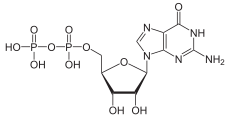Guanosine diphosphate,abbreviatedGDP,is anucleoside diphosphate.It is anesterofpyrophosphoric acidwith thenucleosideguanosine.GDP consists of apyrophosphategroup,apentosesugarribose,and thenucleobaseguanine.[1]

| |

| |
| Identifiers | |
|---|---|
3D model (JSmol)
|
|
| ChEBI | |
| ChEMBL | |
| ChemSpider | |
PubChemCID
|
|
| UNII | |
CompTox Dashboard(EPA)
|
|
| |
| |
| Properties | |
| C10H15N5O11P2 | |
| Molar mass | 443.200522 |
Except where otherwise noted, data are given for materials in theirstandard state(at 25 °C [77 °F], 100 kPa).
| |
GDP is the product ofGTPdephosphorylationbyGTPases,e.g., theG-proteinsthat are involved insignal transduction.
GDP is converted into GTP with the help ofpyruvate kinaseand phosphoenolpyruvate.
GDP and GTP
editHydrolysis of GTP into GDP
editThe hydrolysis of GTP to GDP is facilitated byGTPaseenzymes, which utilize a conserved active site motif known as theGTPase-activating protein(GAP). Initially, a water molecule is coordinated by the active site residues of the GTPase enzyme. The water molecule attacks the γ-phosphate of GTP, leading to the formation of a pentavalent transition state. This transition state is stabilized by interactions with the active site residues, including conserved catalytic residues. As a result, the γ-phosphate is cleaved, and inorganic phosphate (Pi) is released. This step also causes a conformational change in the enzyme that promotes the release of GDP.[2]
Biochemical functions
editIntracellular signaling
editGDP is involved in intracellular signaling processes functioning as a critical regulator in the activity of GTPases. GTPases act as molecular switches, cycling between an active GTP-bound state and an inactive GDP-bound state. The interconversion between GDP and GTP is tightly controlled and serves as a molecular timer for signal transduction pathways. When an extracellular signal triggers the activation of aG-protein coupled receptor(GPCR), the associated G-protein exchanges its bound GDP for GTP, leading to a conformational change and activation of downstream signaling cascades.[3]This activation can stimulate a variety of cellular responses, including modulation of gene expression, cytoskeletal rearrangements, and regulation of enzymatic activities. The hydrolysis of GTP to GDP by the GTPase activity of the G-protein restoring the inactive state, thus terminates the signaling event.[4]
In a type of intracellular signaling referred to as the Nuclear Import process, cytosolic proteins like alpha and beta importins would bind the nuclear localization sequence that is located within the protein, to which this complex would bind to a nuclear pore complex that allows for translocation into the nucleus.[5]RanGTPase would bind to the beta importin which removes it from the complex, followed by the removal of the alpha importin which is also bound to the RanGTPase. While bound to the RanGTPase, the importins leave the nucleus where the Ran is hydrolyzed, converting the bound GTP into GDP. Ran-GDP can return the nucleus through its bind to a nuclear transport factor, where a Guanine Nucleotide Exchange Factor Protein can come to catalyze the exchange of GTP for GDP. We also see GTP hydrolysis in situations with Ras proteins in which the same reaction occurs.[6]
See also
editReferences
edit- ^Crane, Laura J; Miller, David Lee (1974). "Guanosine triphosphate and guanosine diphosphate as conformation-determining molecules. Differential interaction of a fluorescent probe with the guanosine nucleotide complexes of bacterial elongation factor Tu".Biochemistry.13(5): 933–939.doi:10.1021/bi00702a017.PMID4591619.
- ^Calixto, Ana R.; Moreira, Cátia; Pabis, Anna; Kötting, Carsten; Gerwert, Klaus; Rudack, Till; Kamerlin, Shina C.L. (2019-07-10)."GTP Hydrolysis Without an Active Site Base: A Unifying Mechanism for Ras and Related GTPases".Journal of the American Chemical Society.141(27): 10684–10701.doi:10.1021/jacs.9b03193.ISSN0002-7863.PMID31199130.
- ^Downes, G. B.; Gautam, N. (1999-12-15)."The G protein subunit gene families".Genomics.62(3): 544–552.doi:10.1006/geno.1999.5992.ISSN0888-7543.PMID10644457.
- ^Schmidt, Anja; Hall, Alan (2002-07-01)."Guanine nucleotide exchange factors for Rho GTPases: turning on the switch".Genes & Development.16(13): 1587–1609.doi:10.1101/gad.1003302.ISSN0890-9369.PMID12101119.
- ^Thompson, Marilyn E. (15 July 2018)."BRCA1 16 years later: nuclear import and export processes".The FEBS Journal.277(15): 3072–3078.doi:10.1111/j.1742-4658.2010.07733.x.ISSN1742-464X.PMID20608972.
- ^Shutes, Adam; Der, Channing J. (2006-01-01)."Real-Time in Vitro Measurement of Intrinsic and Ras GAP-Mediated GTP Hydrolysis".Regulators and Effectors of Small GTPases: Ras Family.Methods in Enzymology. Vol. 407. Academic Press. pp. 9–22.doi:10.1016/s0076-6879(05)07002-3.ISBN978-0-12-182812-7.PMID16757310.Retrieved2024-04-25.